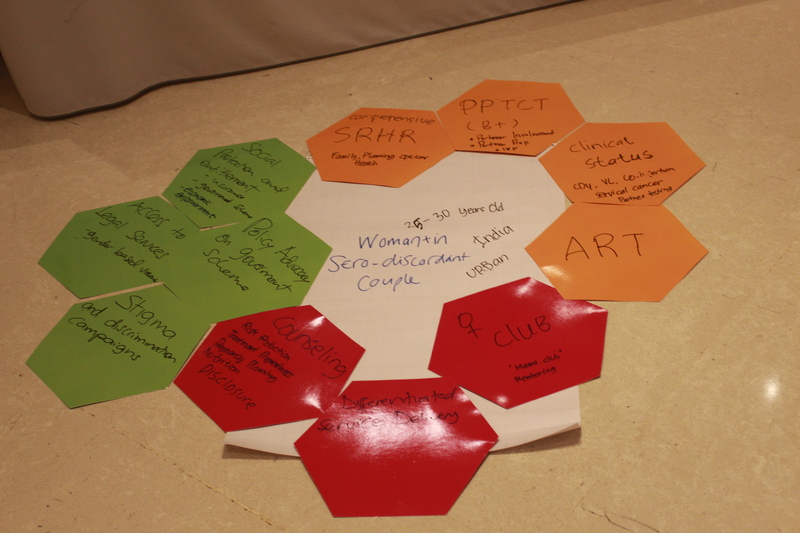To prevent HIV we must end gender-based violence
 © Corrie Wingate for Frontline AIDS
© Corrie Wingate for Frontline AIDS
Gender-based violence is not only a human rights violation but also a barrier to HIV prevention, treatment and care.
Luisa Orza is the Alliance’s technical lead on gender.
There is growing evidence that gender-based violence is not only a human rights violation but also a barrier to HIV prevention, treatment and care. Combination prevention efforts – which combine biomedical, behavioural and structural approaches – must include interventions to prevent and address gender-based violence if we are to achieve the goal of eliminating AIDS as a public health threat by 2030.
How is gender-based violence preventing HIV prevention?
The World Health Organization (WHO) has identified four critical pathways linking gender-based violence and HIV. The most obvious one is the direct risk of HIV transmission caused by sexual violence and rape.
Another direct link between gender-based violence and HIV is HIV diagnosis and disclosure acting as a trigger for different forms of violence against women living with HIV. This can include, but is not limited to, intimate partner violence and violence in healthcare systems, such as the forced or coerced sterilization of women living with HIV.
Gender inequality links gender-based violence and HIV as one of two indirect pathways that have even greater impact on HIV transmission than the direct pathways. In societies where patriarchy and unequal gender norms are deeply entrenched, men are more likely to perpetrate sexual violence, pay for sex, and are less likely to use condoms.
Intimate partner violence is also an indirect risk factor for HIV acquisition, as women who experience intimate partner violence have more mental health issues, including depression and anxiety, higher use of alcohol and less control over their sexual decisions. Experience of intimate partner violence increases the likelihood that a woman will acquire HIV by up to 55%.
Successful community approaches to gender-based violence
The Actions Linking Initiatives on Violence against Women and HIV Everywhere (ALIV[H]E) Framework change matrix below describes the four realms of power that responses to gender-based violence must address.
![ALIV[H]E change matrix](/wp-content/uploads/old_site/alivhe_matrix_detail_fixed_proportions.jpg?1520441610)
Action Linking Initiatives on Violence Against Women and HIV Everywhere, ALIV(H)E framework: Salamander Trust, Athena, UNAIDS, AIDS Legal Network, Project Empower, HEARD, University of KwaZulu-Natal (2017). The matrix is adapted from the Gender at Work Analytical Framework.
At the “Championing HIV Prevention – advocacy for and by communities” workshop recently hosted by the India HIV/AIDS Alliance and the International HIV/AIDS Alliance, advocates representing key populations from ten countries in Africa, Eastern Europe and Asia came together to learn and share experiences around HIV prevention.
Workshop participants shared examples of successful approaches to recognise and address gender-based violence.
In Ukraine, ‘Hope and Trust’ – a network of women who use drugs – has trained its members to conduct research to gain a deep understanding of issues faced by women who use drugs, who are often left out of harm reduction services.
Preliminary findings show that 80% of the women taking part in the research had not been able to access ante-natal or maternal health services prior to the birth of their child; 50% were unaware of harm reduction services available to them during pregnancy; and 30% had undergone terminations in the belief that it would be impossible for them to give birth to a healthy child.This kind of research is the first step towards informing gender responsive programming and advocacy that is rooted in the lived realities of women who use drugs.

Workshop participants identify access to legal services for women experiencing gender-based violence (far left green hexagon) as a necessary part of combination prevention programmes for women living with HIV in sero-discordant relationships.
Sex workers face many forms of gender-based violence including sexual violence and rape (often not recognised either by clients or the police); financial violence or extortion; emotional violence from neighbours and community members; and physical violence from intimate partners, clients and pimps.
Following a high volume of reports of violence against sex workers, the Bar Hostess Empowerment and Support Programme (BHESP) in Kenya initiated a grassroots ‘alternative dispute resolution’ mechanism in 2017. Based in the community, these ‘settlement conferences’ are quicker, cheaper and easier than formal court processes for sex workers to access, which encourages more sex workers to report cases of abuse or violence. (Rape cases must still be referred to formal court processes). Decisions made are binding, non-biased and negotiated between parties, which helps preserve relationships between sex workers and clients or police.
In Indonesia, the network of women living with HIV has used shadow reporting to ensure that women living with HIV are represented in the civil society report to the commission of the Convention on the Elimination of all forms of Discrimination Against Women (CEDAW), drawing attention to issues of forced and coerced sterilisation of women living with HIV.
They have also piloted integrated HIV and gender-based violence services in two districts by setting up referral systems. The programme built the knowledge of service providers about how gender-based violence can contribute to HIV risk, and how HIV can put women at risk of violence, as well as building rights awareness among women living with HIV themselves.
Importantly, all these examples are community-led and person-centred, so that solutions both reflect the lived realities of the communities most affected by HIV and violence, and are embedded within community structures. This adds to the sustainability of the solutions, and increases their potential to be ‘gender transformative’, i.e. they challenge and reverse the social norms and power relations that make some communities more vulnerable to violence in the first place, by putting the most affected communities in the driving seat.
This article was written as the International HIV/AIDS Alliance, before we changed our name to Frontline AIDS.
Tags
Gender equalityGender-based violenceHIV preventionHIV treatment


